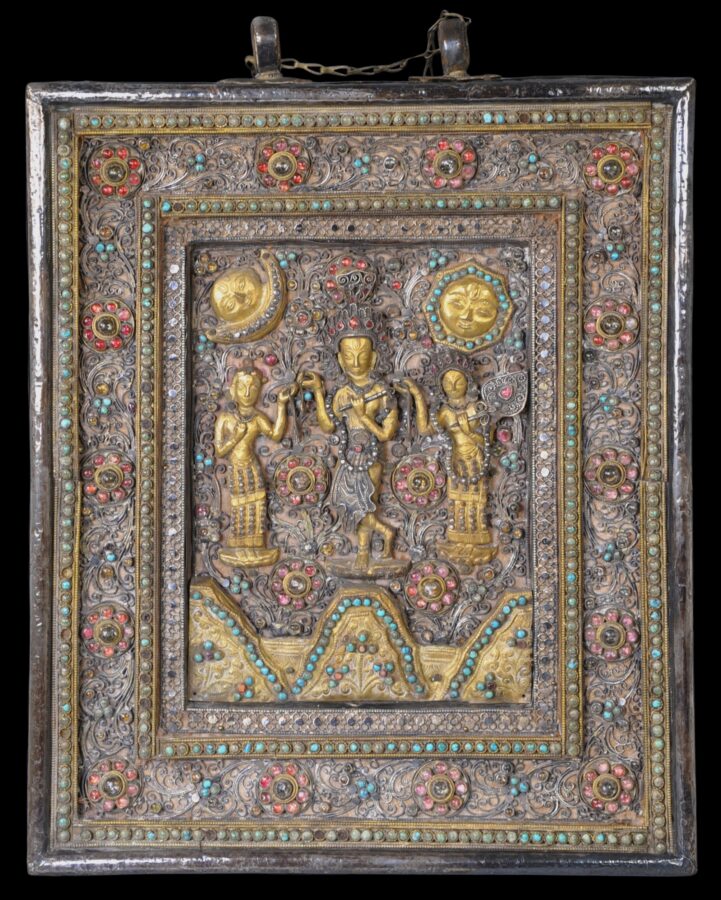Enquiry about object: 10029
Nepalese Gem-set Silver & Gilt Votive Plaque
Kathmandu Valley, Nepal 18th-early 19th century
height: 34.4cm, width: 26.3cm, depth: 4.4cm, weight: 2,336g
Provenance
UK art market
This framed jewelled plaque shows three deities, probably Krishna in the middle. Each stands on a lotus platform. A moon and a sun emblem (each with a Vaishnava tilaka) is shown in either of the top corners.
These, the deities, and the turquoise-inset rocky foreground, are of gilded copper. Each deity would have worn a crown but that on the left has lost hers.
The plaque is thickly inset with rubies and turquoise cabochons amid copious gilded silver filigree work. The deities are surrounded by scrollwork arrayed as vines and tendrils terminating with large flowerheads inset with ruby cabochons for petals and rock crystal centres. The outer border of the plaque is similarly decorated.
The frame comprises silver sheet pinned to wood. The reverse has a sheet copper backing. Two loops at the top all the plaque to be hung, and the original copper chain remains for that purpose.
In Hindu scriptures, Krishna is associated with the sun and the moon. Each represents different aspects of Krishna’s divine nature – the sun’s radiance and the moon’s cool light being manifestations of his energy.
Such plaques were made to be kept in the household shrine of a wealthy home. Others were donated to temples.
This type of plaque is peculiar to Nepal. They were made for both Buddhist and Hindu households. The example here is Hindu.
It is a fine example of Newar metalwork and stone inlay from the Kathmandu Valley. The fashion for this type of inlay which involves the use of cloisons and thin strips of metal to hold the gems in place, usually together with spiral filigree, is known as jarao or jadoba.
The wear, patina of the the gilding, lack of faceting to the stones, and the simple box settings for the stones suggest an 18th-early 19th century dating for this piece. Boxes similarly decorated in the Jacques Marchais Museum of Tibetan Art are accorded a 17th-18th century dating. The Metropolitan Museum of Art uses a wider dating of 17th-19th for Newar items with related decoration.
The plaque here is in fine condition despite its obvious significant age. There are minor losses to the stones here and there, and the deity on the left has lost some of its decoration. Otherwise, the plaque and its decoration is surprisingly-well intact.
References
Bazin, N., et al, Nepal: Art de le Vallee de Katmandou, Musee National des Arts Asiatiques – Guimet, 2021.
Bromberg, A., et al., The Arts of India, Southeast Asia, and the Himalayas: At the Dallas Museum of Art, Yale University Press, 2013.
Casey Singer, J., Gold Jewelry from Tibet and Nepal, Thames & Hudson, 1996.
Clarke, J., Jewellery of Tibet and the Himalayas, V&A Publications, 2004.
Ghose, M. (ed.), Vanishing Beauty: Asian Jewelry and Ritual Objects from the Barbara and David Kipper Collection, Art Institute of Chicago, 2016.
Lipton, B., & N.D. Ragnubs, Treasures of Tibetan Art: Collections of the Jacques Marchais Museum of Tibetan Art, Oxford University Press, 1996.
Pal, P., Nepal: Where the Gods are Young, The Asia Society, 1975









